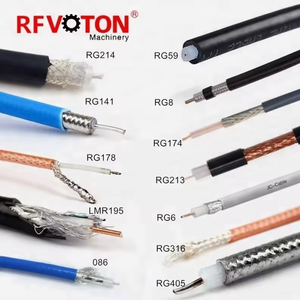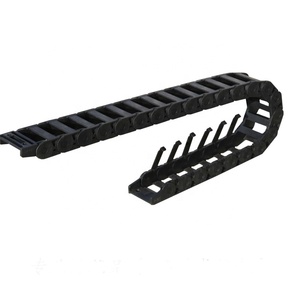
All categories
Featured selections
Trade Assurance
Buyer Central
Help Center
Get the app
Become a supplier

(6935 products available)



























Drum reeling cable comes in various types. They differ in construction and application requirements.
These cables are used to transmit high voltage electricity. They have conductive cores that are made of copper or aluminum. The cores are insulated with rubber or polyethylene. These insulations allow the cables to carry electricity safely.
Reel-up connectors are favored because they are lightweight yet tough and can handle heavy loads. This makes them great for moving equipment.
Control cables are designed to connect machinery components. They work by transferring control signals. Their wires are flexible, making them easy to handle during installation. This is especially important in tight spaces or in intricate machinery.
On the other hand, instrumentation cables are used for measurement and monitoring systems. They feature multipair wires that facilitate signal transmission. The wires come with shielding to protect them from electromagnetic interference.
These cables are primarily used in offshore industries. In these kinds of cables, a hydraulic system is used instead of an electric one. These systems are great for heavy equipment. The wire’s jacket protects it from dangerous oil and chemical spills.
Lastly, fiber optic reeling cables are specially designed to wind up fiber optic cables for easy storage and transport. Their reels have a shock-absorbing capability that protects the delicate glass fibers inside the cable. This makes them suitable for construction, military, and event management companies.
The drum reeling cable comes with many applications in industrial settings. The most common of these is in mining operations. Its flexibility allows the cables to function well in mobile machinery.
Also, the reeling feature allows for easy installation and mobility in large, complex sites. It ensures that power or signals are continuously supplied to equipment as they move about.
Cables that are used in mining are typically durable and resistant to wear. This is because mining can be extremely demanding on equipment.
Marine operations also use drum reeling cables. These cables are used in ships, offshore platforms, and other marine infrastructure to transmit power and control signals.
These harsh marine environments require cables to be resistant to corrosion and water damage. This makes longer-lasting cables ideal for this industry.
Cables that are suitable for marine industry application are often made with corrosion-resistant materials. They can also be customized with longer lifespans for this industry.
Construction companies also use drum reeling cables to power tools and equipment. These cables allow workers to easily reel out or retract cables as needed, keeping job sites organized.
In event management, organizations use flexible cables to power stages, lighting systems, and sound equipment. These cables are easily transportable and can be maneuvered into tight spaces.
Industrial facilities that are located in hazardous areas also have communications and control systems powered by these cables.
Choosing the right cable reel requires one to consider its main specifications. Key among these are conductor count and cross-sectional area.
Conductor count relates to how many inner wires are in the cable. Larger cables usually have more conductors. These support complex systems that need more wires for signals or controls. Poole, power cables have fewer conductors compared to control and instrumentation cables.
The cross-sectional area affects how much current the cable can carry. Larger areas can transmit more current. Therefore, cables meant for high-power jobs will have larger cross-sectional areas. On the flip side, smaller spaces are enough for lighter applications.
For materials, insulation type and thickness are crucial. Insulations made from rubber and plastics are resistant to heat and chemicals. This makes them ideal for harsh working environments. The thickness of the insulation will directly affect the lifetime of the reeling cable. Those with thicker insulation can last longer. This is especially true in environments that are tough on equipment.
Lastly, the outer sheath serves as an extra protective layer for the cable. It protects the cable from threats such as moisture and oils. Each cable has a different outer sheath. Manufacturers make them using various materials. This is primarily based on the environment they will be exposed to.
There are many factors to consider when selecting drum reeling cables.
The first factor is the working environment. It will determine the cable’s insulation. Cables used in outdoors spaces should have UV-resistant outer jackets. Further, cables used in the marine and mining industries should be made from corrosion and moisture-resistant materials.
That is why suppliers recommend aluminum drums for mining or marine environments. The aluminum provides corrosion protection of up to five years. The right insulation should also be selected to protect the cables from extreme temperatures.
Once the outer jackets are selected, the load the cable will be carrying should be considered. Drum reeling cables come in different sheave sizes. The size of the sheave is proportional to the cable’s minimum bend radius. This allows the cable to bend without straining it.
Go for cables with smaller sheaves if the space the cable is going to be used in is relatively small. However, if the environment is large, larger sheaves will do just fine. Different industries have different voltage and current requirements.
That is why the reeling cable is equipped with conductors that help meet those requirements. The cables are designed with varying conductor counts and diameters.
Lastly, consider the duration of operation. Generally, continuous operation cables are meant for jobs that require constant use. Temporary-use cables are designed for short-duration tasks. These cables are easier to handle as they are lighter in weight.
A1: It is a flexible power and control cable. The cable’s flexibility makes it ideal for dynamic applications where the cable will be subject to constant movement or bending.
A2: The reeling cable’s insulation protects it from abrasion, chemicals, and environmental factors. It also ensures safety by preventing electrical leakage.
A3: One should consider the environment and application the cable will be used in. Other factors to consider include load requirements, operational conditions, and space constraints.
A4: The outer sheath of a reeling cable is generally made from thermoplastic elastomers, PVC, or rubber blends. Each material offers different levels of resistance to factors like abrasion, oil, and chemical exposure.
A5: Continuous duty cables are designed for long-term, unceasing operations. They have stronger materials and better resilience to wear and tear. Meanwhile, intermittent duty cables are for shorter, cyclical uses. They are lighter and more cost-effective.